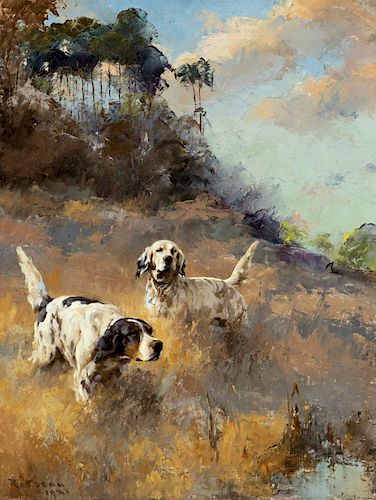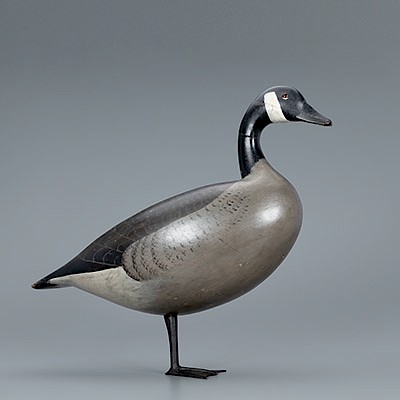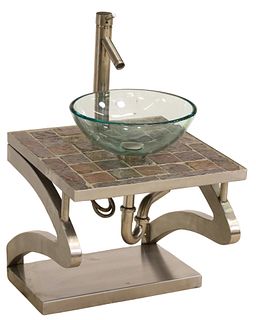Percival Leonard Rosseau (1859-1937) Perfection: Ned and Bob
Lot 4
About Seller
Copley Fine Art Auctions
20 Winter Street
Pembroke, MA 02359
United States
Founded in 2005, Copley Fine Art Auctions is a boutique auction house specializing in antique decoys and American, sporting, and wildlife paintings. Over the course of the last two decades, the firm has set auction records for not only individual decoy makers, but also entire carving regions. Copley...Read more
Estimate:
$30,000 - $50,000
Absentee vs Live bid
Two ways to bid:
- Leave a max absentee bid and the platform will bid on your behalf up to your maximum bid during the live auction.
- Bid live during the auction and your bids will be submitted real-time to the auctioneer.
Bid Increments
| Price | Bid Increment |
|---|---|
| $0 | $50 |
| $1,000 | $100 |
| $2,500 | $250 |
| $5,000 | $500 |
| $10,000 | $1,000 |
| $25,000 | $2,500 |
| $50,000 | $5,000 |
About Auction
By Copley Fine Art Auctions
Feb 16, 2019
Set Reminder
2019-02-16 10:00:00
2019-02-16 10:00:00
America/New_York
Bidsquare
Bidsquare : The Winter Sale 2019
https://www.bidsquare.com/auctions/copley/the-winter-sale-2019-3820
The sale will offer the opportunity to view and take home world-class paintings and fine bird carvings. Featuring selections from the collections of Alfred Ely, L. H. LaMonte, Grant Nelson, Ronald S. Swanson, Herb Wetanson, and a descendant of Chester F. Spear among others. Copley Fine Art Auctions cinnie@copleyart.com
The sale will offer the opportunity to view and take home world-class paintings and fine bird carvings. Featuring selections from the collections of Alfred Ely, L. H. LaMonte, Grant Nelson, Ronald S. Swanson, Herb Wetanson, and a descendant of Chester F. Spear among others. Copley Fine Art Auctions cinnie@copleyart.com
- Lot Description
Percival Leonard Rosseau (1859-1937)
Perfection: Ned and Bob, 1928
signed and dated "Rosseau 1928" lower left
oil on canvas, 18 by 14 in.
John Levy Galleries, New York and The Sportsman's Gallery, Atlanta, Georgia labels on back
This stunning painting depicts two dogs, Ned and Bob, owned by industrialist and sportsman Samuel G. Allen. Ned, a black and white setter, is featured in a 1920 Country Life article about shooting bobwhite quail in North Carolina by James Boyd. In addition to the photographs of quail and dogs, four paintings by Percival Rosseau illustrate the article.
Rosseau was born near Baton Rouge, Louisiana. Although considered a premier painter of sporting dogs, he did not pick up a paintbrush until the age of thirty-five. After leaving an eclectic business career, including stints as a cowboy and a lumberjack, he sailed to Paris to attend the Académie Julian. His entry at the 1904 Paris Salon, a painting of a pair of Irish wolfhounds, gained him pivotal acclaim. He returned to the United States where he found a ready market for his work among wealthy sportsmen and received many commissions from first-rate breeders of pointers and setters. Rosseau’s best works capture the tense action of hunting dogs and depict them in romantic landscapes.
Among these patrons was Percy Rockefeller, nephew of oil tycoon John. D. Rockefeller and a successful businessman in his own right. Along with several investors, Rockefeller built Overhills, a private hunt and country club with stables and kennels in Cumberland County, North Carolina. He kept a cottage on the property for Rosseau to use when he traveled to the state, and the artist painted there throughout the 1920s and 1930s. Allen likely met Rosseau through Rockefeller in the rarified hunt scene in North Carolina at the time.
Dog historian A. F. Hochwalt writes, “Eventually such men as Samuel G. Allen, Harry D. Kirkover and others who own high class shooting dogs began to cultivate his acquaintance, for artists who can portray the pointer and the setter, as he really appears in the field, those who are able to transfer to canvas an actual hunting scene where the dog is not a mere caricature, are few and far between the world over, but particularly so here in America.”
Samuel “Allen, very well known in railway circles, has for many years been a nationally-known figure in field sports, with a wide range of experience. His kennels of fine hunting dogs at Pinehurst, North Carolina, are the envy of field trial enthusiasts,” notes Hochwalt in American Game.
The New York Times reported on a Pinehurst field trial in 1929: “Hunting-dog owners from many sections had begun to arrive here tonight for the annual championship meet of the Pointer Club of America... William H. McNaughton of Jersey City, secretary of the Pointer Club, is among those here. Others are Harry D. Kirkover of Buffalo, Samuel G. Allen of New York and Elmer Simkins of Greenwich, Conn. The trials offer the richest stakes in the East and the entry is expected to set a record.”
Allen judged multiple groups at the Westminster Dog Show over many years. His wife supported Bide-a-Wee Home for Animals in New York. He registered the Peerless Kennels in New York City in 1916 and opened a kennel with Elmer M. Simkins in Red Bank, New Jersey, to breed setters and pointers. Allen was one of the founders of the English Springer Spaniel Field Trial Association in 1922, and he served on a committee to create “Standards of Judicial Practice and Field Trial Procedure” published in 1950.
During World War I, Allen led the New York district of the Production Division of the Ordnance Department to increase production. He purchased Lima Locomotive Co. in 1916, and, according to his New York Times obituary, he “was chairman of the Combustion Engineering Company of New York and a director of the Franklin Railway Supply Company of Warren, Pa. For many years he had been with the Baldwin Locomotive Works and the Lima Locomotive Works.” He was a founder of the Westchester Country Club in Rye, New York, where he built his estate in 1918.
Rosseau’s debt to the Barbizon tradition is apparent in Perfection - Ned and Bob, with its softly defined brushstrokes, rich colors, and pastoral setting. This work features two of the dogs from the Allen kennel. The setters are perfectly positioned in the composition, leading the viewer’s eye into the distance. With its finely rendered dogs and warm, golden foreground, Perfection - Ned and Bob, is one of Rosseau’s true gems.
Provenance: Samuel G. Allen Collection, Pinehurst, North Carolina
William Kerr Collection, Jackson, Wyoming, acquired from The Sportsman’s Edge Gallery, New York, c. 1970
Private Collection, Atlanta, Georgia, 2003
Private Collection, Pennsylvania, acquired from The Sportsman’s Gallery, Atlanta, Georgia, 2010
Literature: James Boyd, “Bird-Shooting With A Camera,” Country Life, Volume XXXVIII, No. 5, September, 1920.
Albert Frederick Hochwalt, Bird Dogs: Their History and Achievements, Cincinnati, OH, 1922.
“Some Great Shooting Dogs,” A.F. Hochwalt, ed., Outdoor Recreation, Vol. LXII, No. 1, January, 1920.
American Game, Washington, D.C., 1929.
“Pointer Meet To Open: Hunting-Dog Owners at Pinehurst for Trials Starting Tomorrow,” The New York Times, December 15, 1929.
“Samuel G. Allen, 86, Industrialist, Dies” The New York Times, October 17, 1956.
CSR Blue Book of Dogdom, New York, NY, 1916.
American Game Protective Association, American Game, Washington, D.C., 1929.
Condition report requests can be made via email or by telephone (info@copleyart.com or 617.536.0030). Any condition statement given is a courtesy to customers, Copley will not be held responsible for any errors or omissions. The absence of a condition statement does not imply that the lot is in perfect condition.Condition
- Shipping Info
-
Shipping info
Copley Fine Art Auctions does not handle the shipping of any items. Shipping is the sole responsibility of the buyer. Once your payment has cleared, and we have received your authorized shipping release form items may be released for shipment. Copley Fine Art Auctions, LLC shall have no liability for any loss or damage to such items. Buyers should allow up to four weeks for shipment.Please be aware that internet bidders may NOT not pick up their items at the sale. Items will be available for pick up by appointment or by shippers five days after the sale.
-



 EUR
EUR CAD
CAD AUD
AUD GBP
GBP MXN
MXN HKD
HKD CNY
CNY MYR
MYR SEK
SEK SGD
SGD CHF
CHF THB
THB














